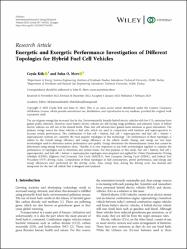Energetic and Exergetic Performance Investigation of Different Topologies for Hybrid Fuel Cell Vehicles
Künye
Kök, C., Mert, S.O. (2023). Energetic and Exergetic Performance Investigation of Different Topologies for Hybrid Fuel Cell Vehicles. International Journal of Energy Research, 2023, art. no. 7165382. https://doi.org/10.1155/2023/7165382Özet
The use of green energy has increased day by day. Environmentally friendly hybrid electric vehicles with low CO2 emissions have gained public attention. However, most battery electric vehicles are still having range problems, and emission values of hybrid electric vehicles are still not at the desired levels. Thus, fuel cell vehicles have gained some attention as good alternatives. The primary energy source for these vehicles is fuel cells, which are used in conjunction with batteries and supercapacitors to increase system performance. The combination of fuel cell + battery, fuel cell + supercapacitor, and fuel cell + battery + supercapacitor systems are currently the most popular topologies in this technology. The performance of these topologies is related to the overall energy efficiency and exergy efficiency of the vehicle model. Energy and exergy are two basic terminologies used to determine system performance and quality. Exergy determines the thermodynamic losses that cannot be determined using energy formulations alone. Thereby, it is very important to use both terminologies together to examine the performance of topologies and to determine any system losses. For this purpose, in this study, fuel cell + battery, fuel cell + supercapacitor, and fuel cell + battery + supercapacitor topologies were prepared and applied for Urban Dynamometer Driving Schedule (UDDS), Highway Fuel Economy Test Cycle (HWFET), New European Driving Cycle (NEDC), and Federal Test Procedure (FTP) driving cycles. Comparisons of these topologies in fuel consumption, power performance, and energy and exergy efficiencies were performed for the driving cycles. Also, energy flow, during the driving cycle, has showed and interpreted for the fuel cell vehicle that is designed and analyzed.
Kaynak
International Journal of Energy ResearchBağlantı
https://doi.org/10.1155/2023/7165382https://www.hindawi.com/journals/ijer/2023/7165382/
https://hdl.handle.net/20.500.12508/2724
















